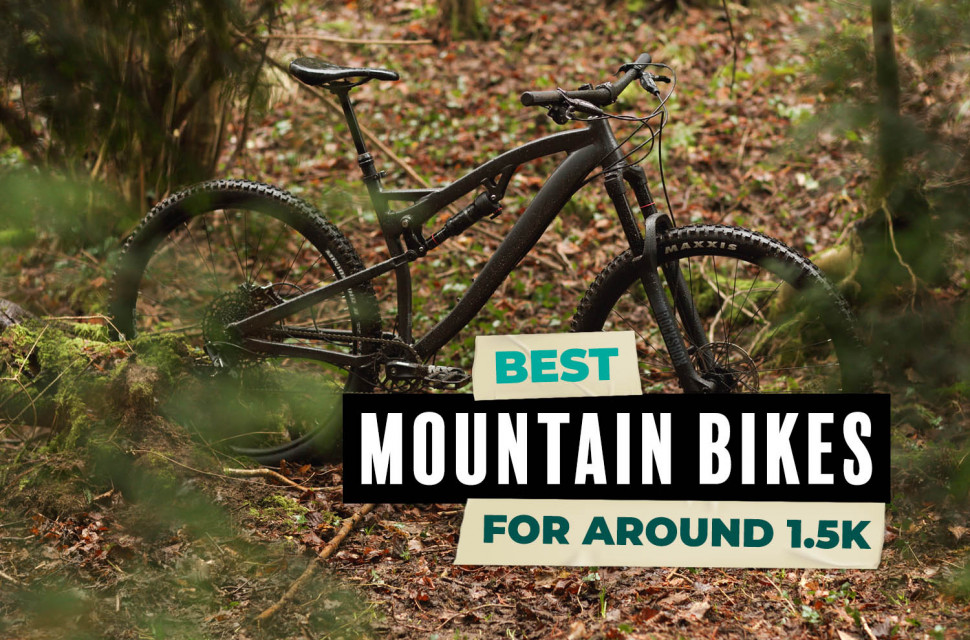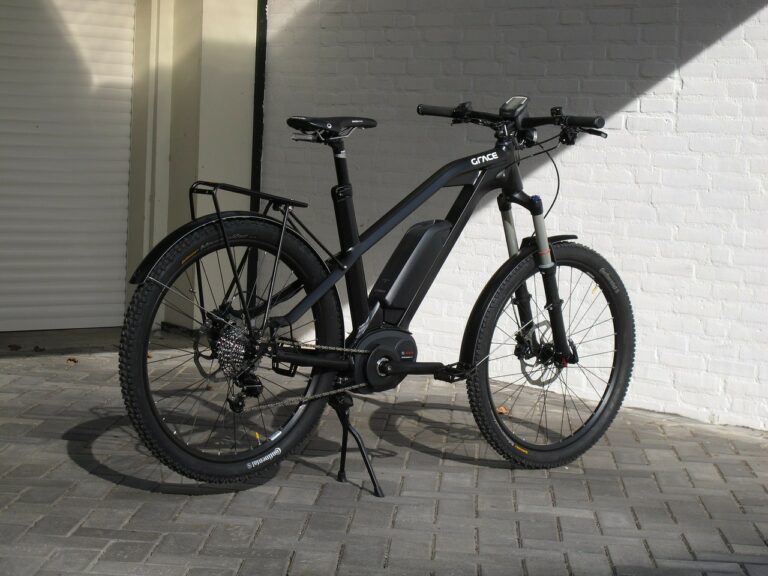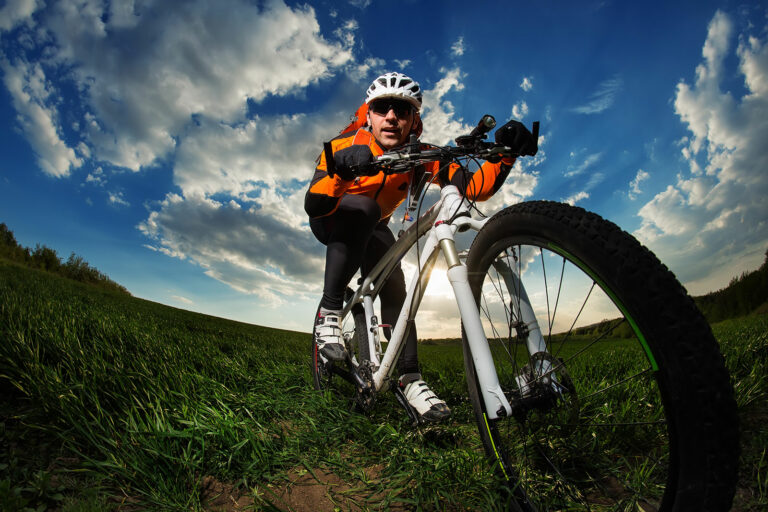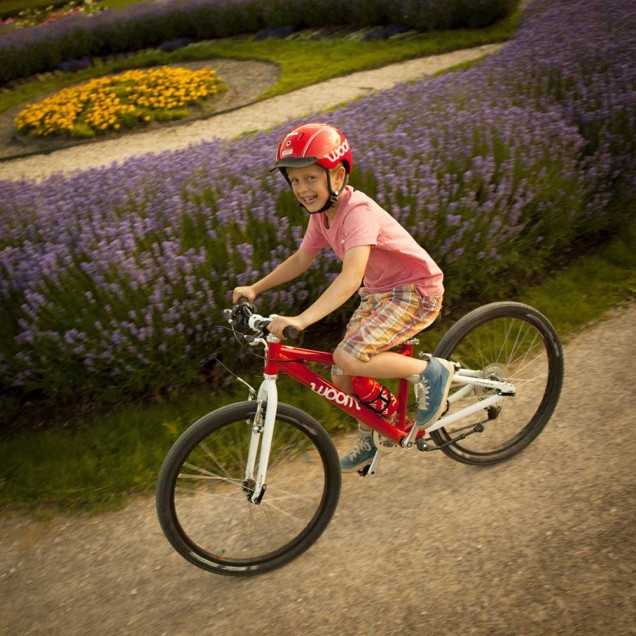The best hardtail and full suspension mountain bikes you can buy for around £1,500
(Updated July 22, 2021)
If you are looking to spend around a grand and a half on a brand spanking new mountain bike, we check out just what you get for your money in the model year 2021. There used to be a rule of thumb in the £1,500 category that you might be better off buying a well-specced hardtail rather than a cheaper full suspension bike. That’s rapidly changing now and there are some notable exceptions to the rule which we list here. Read on for the best mountain bikes we have ridden that you can buy for around £1,500, or check out the video directly below.
Either scroll away or hit the links below to scroll straight to the bike of your choice:
If you’re looking for a solid first full suspension bike, or you’re simply on a budget, it’s pretty tough to go wrong with the 2021 Boardman MTR 8.9. Its geometry is spot on for a range of riding; if you’re a newbie it’ll grow with you as you progress, while if you’re a veteran it’s ready and raring to be thrown down your favourite tracks.
It has the kit to back up the geometry too – more aggressive riders may want to swap the fork, but that’s the only meaningful fly in the ointment.
Tester Liam writes: “The MTR’s 75.5° seat tube angle places rider weight at a really comfortable position over the pedals. Paired with the relative lack of pedal bob it makes for a keen and comfortable climber that doesn’t sap too much energy.
I’ve been able to wrench myself up climbs with surprising speed and comfort, making that one last descent extra appealing. Not that ‘one last run’ is ever a good idea…
Get out of the saddle and mash on the pedals and the bike’s pretty reluctant to get up to speed… at least with 30% sag, anyway. Once firmed up to 25% the MTR – while still giving away a chunk of travel when sprinting – calms down nicely, to the point where it’s not much of a problem at all.”
The Big.Trail 600 from Merida is a trail-ready 29-inch-wheeled hardtail that’s impressively capable and nicely specced. It comes with a few neat touches and a ride that’ll please both new and experienced riders alike.
The 600 sits atop a range of four builds. The lineup kicks off at a friendly £800 for the 200 model, and tops out at £1,600 for the bike you see here.
Handling the bike’s 140mm of suspension is the mighty Marzocchi Bomber Z2. As a budget-friendly fork, it’s a difficult unit to fault. It’s simple with just rebound and compression adjustment, but it’s supple, really nicely damped and plenty stiff enough for a bike like this.
Tester Liam writes: “Once the Big.Trail is pointed downhill, the 475mm reach and 65.5° head angle make for a bike that can tackle an awful lot.
“Having that much bike out front is, for the most part, what makes this bike such a solid all-rounder. It makes the Big.Trail stable at speed and impressively confident when the trail drops away. That short seat tube only helps here, offering loads of room to shift weight towards the back of the bike.
“This is where the bike’s Marzocchi Bomber Z2 starts to shine. It’s supple, soaking up an awful lot of small bumps, and composed enough to stop you pinging offline. Its 140mm of squish is also reasonably well supported, staying nicely propped up when the trail steepens. That leaves you with a bit of extra travel to get you out of trouble when you really need it.
“That fork, combined with the Big.Trails extra large geo and the 29-inch hoops, do a lot to tame proper chunky trails. The bike noticeably retains momentum through the rough stuff without rattling your arms to pieces. It’s only your ankles you need to worry about.”
The Ribble HT 725 Sport is a great 150mm steel hardtail for those on a budget. It’s progressive, good looking and built for gravity-fed riding – it ticks most boxes for hardtail lovers
Tester Rachael writes: “The geometry is as gravity-fed as the build, with the frame and 150mm fork giving the bike a 64 degree head angle. Reach is roomy too at 455mm on this medium, meaning there’s plenty of space to centre yourself on this long bike, and to move around when things get lively.
“It’s not twitchy, it’s reliable and predictable – it’s happy both at speed in a straight line and pumping through tight corners.
“The short seat tube adds to the feel of extra room, too. It’s 406mm on this medium frame, giving plenty of room for long dropper posts and getting that saddle well out of the way on the steep stuff.
“As an entry point into the hardtail market – if you have a preference for riding down hills – the Ribble is good value in its Sport Build. If you do upgrade anything before purchase, though, ignore the drivetrain and make it the fork. While it’s a shame there’s no 29er version, the HT 725 really can make very good use of the broad 27.5-inch hoops it does wear.”
The Marley 1.0 is Ragley’s alloy trail hardtail, and it’s impressively capable while being heaps of fun on a range of trails. Ragley has been wise with the spec and for the most part, the geometry is on point. However, it trades climbing excellence for its downhill prowess.
Tester Liam writes: “Having ridden the very well-reviewed Ragley Blue Pig briefly last year, I was excited to swing a leg over the Marley 1.0 – and happily, it feels equally as ‘Ragley’. The alloy frame of the Marley carries the same build quality as the pricer, steel-framed Blue Pig, and shares the same cockpit too.
“It doesn’t take long to feel comfortable on the Marley. It offers a roomy riding position thanks to its 50mm stem and slack-ish seat tube. This gives you plenty of space to shift weight fore and aft when out of the saddle and, for the most part, that saddle’s a pleasant place to be.
“Once the speed rises, this bike shows its hand as a true purveyor of the 650B wheel. It’s agile and great fun in the corners, it’s quick on the pedals and it’s got me loving mellower trails – popping off little rock lips and manualling through rollers is easy, thanks to those short chainstays and the low, 313mm bottom bracket.
“It’s no slouch on more techy trails either. You won’t be piling into chunky sections with the reckless abandon of a full susser – or even a hardtail with a long-travel fork – but the 65.5° head angle makes for an impressively capable ride that doesn’t hold you back from riding them.
“I’m impressed with how composed the Marley 1.0 is over chattery ground at speed, and that’s due to the 2.6in EXO+ cased rear tyre. It provides just enough damping to keep your eyes in their sockets when hurtling down spiky sections, but stays stiff enough to stop the wheel exploding unless things go very wrong.”
The Vitus Mythique 29 VRS is a solid performer at the budget end of the scale. The 1×12 drivetrain is a real advantage and the geometry suits whatever kind of riding you fancy, while the tyres are a great spec for UK use. While some components underperform – the X-Fusion fork and Shimano brakes most notably – they’re okay for the price. What’s more, the Mythique is a bike worth upgrading, and for new riders looking for their first full suspension trail bike (without destroying the bank account), it’s a sensible choice.
Under two grand for a decent 29er has ‘winning’ written all over it, and – slightly dodgy name aside – the designers have done a great job of creating a 140mm full suspension trail bike with decent, predictable geometry for those who do a bit of everything. From steeper techier terrain to mile-munching XC rides, the Mythique does the job well, making it a bargain.
Climbing the Vitus is surprisingly effortless, as the low overall weight and distinct lack of pedal bob from the Horst link suspension makes this an efficient bike. The effective seat tube angle is 75.7°, and the seated climbing position with a 602mm effective top tube is roomy enough.
The Sonder Transmitter is an aluminium trail hardtail with impressive geometry and some good looks, with some obvious thought put into the frame. It is beaten by other bigger brands when it comes to value though, leaving us to make a decision between aggressive geometry or better parts.
The Transmitter is an all mountain trail hardtail designed in the UK from the guys at Sonder and Alpkit. They have a huge array of bikes to choose from and although this is aimed at harder hitting, gravity fed riders, you won’t be disappointed if you are just starting out on your mountain bike journey or if you happen to want to dabble in a spot of bike packing.
Tester Rachael writes: “The Transmitter is an agile bike. There has been some thought into the spec of the wheels and tyres and I reckon they suit this hardtail pretty well, wider rims and tyres providing suspension, grip and comfort where it’s needed and otherwise absent! The steep seat angle is a welcome surprise and I certainly appreciated the more efficient seated position when climbing.
“The Transmitter is a playful, all-mountain rig with some hooligan tendencies. It suits all manners of riding from trail centres to more natural riding to exploring wild bridleways. If you want a ‘one-hardtail-does-it-all’ then the Transmitter will do that in spades.”
The 29-inch-wheeled Chisel range sits at the top end of Specialized’s aluminium framed cross-country hardtail offerings, with the two bike lineup consisting of this bike and the £1,800 Chisel Comp. Both bikes share a very nicely made M5 frame with the so-smooth-it-looks-like-carbon D’Aluisio Smartweld technology stitching it all together.
Tester Jon writes: “The Chisel is an unashamed cross-country machine with rapid handling angles to match the head-down, flat-out intentions. If you’re expected a slacked out trail bike, you’ll be sorely disappointed, but if you want to elevate both yourself and your heart rate at maximum speed, then there’s a lot going for it. It’s got a Boost spaced through axle rear end, a proper threaded bottom bracket and a tapered steerer up front too, plus decent mud clearance from the skinny, unbraced seat stays.
“There’s very little lag between stamping on the pedals and getting going. All in all, the bike is impressively taut feeling; it’s stiff without booting you up the arse too violently when sat down, it’s not soggy under power and it’s certainly not bendy even when you’re hauling on the bars out of the saddle.
“It’s surgically sharp in its response to rider input and will merrily change tack at a moment’s notice; think dog chasing squirrels. In fact, when it comes to putting the hurt on fellow racers, you’d have to be aiming pretty high up the rankings before you could fairly argue that the Chisel was holding you back.”
Tester Rachael writes: “It’s easy to get to grips with this ride straight away, there’s nothing here that is out of the ordinary which will suit a lot of folk.
“When seated the VRS is an efficient place to be despite the slack 73 degree effective seat tube angle, I found this a super bike to crank out quick laps of my local steaming uphill faster then I had planned on many occasion.
“Descending is entertaining too, the VRS is nippy and easy to throw about the trail. I found it most at home on more mellow trails where a quick pedal stroke here and there is on the cards rather than steeper trails where more stability is required. The short reach means that on more than on occasion I felt my weight biased towards the front of the bike, it’s hard to find the centre point of the bike and as such feels unstable downhill especially over chunkier terrain. The 66 degree head angle isn’t all that slack either and as this steepens when the fork compresses, it feels less confidence inspiring.
“Remembering though that this is a trail hardtail and not an aggressive gravity fed machine the Sentier is a fun ride and one that given the price is well specced for the job too, a package that’s hard to beat.”
The bikes of Canyon’s Grand Canyon range are cross-country racers with winning intentions that will be a little easier on your wallet than their competitors and can provide you with just as much speed.
If you are set on pushing your limits on the cross country course then the Grand Canyon will be a good partner. It’s not radically different from other cross-country bikes on the market and it doesn’t break the mould in terms of geometry, but with the help of the 120mm fork on the Grand Canyon, it’s slacker than some cross-country hardtails which I think can only be a good thing.
Tester Rachael writes: “The Grand Canyon is happy to munch up singletrack and mash out miles, although again riders may wish to change the 70mm stem for something shorter. Whilst descending I found the long stem allowed too much weight to be distributed forward of the steering axis and therefore unbalanced the bike on more technical descents.
The reach of this bike is shorter than I’d personally like but it’s on par with its competitors, the Rose Count Solo for one, Specialized Chisel for another and the Scott Scale for yet another. As it is the bike does classic cross-country race geometry with short chainstays (427mm) and a short wheelbase (1112mm) giving nippy handling that only becomes a detriment when pushing hard and fast over rough terrain or steeper tracks. Longer chainstays would aid climbing ability and a longer front centre (and reach) would build a more stable bike that would be more at ease on the ‘A line’ on any cross-country course, with the potential here of making the rider faster. In its current form Canyon has produced a bike that is safe in its niche, works well for it’s given purpose and won’t scare off new folk entering the scene with talk of progressive geometry.”
















